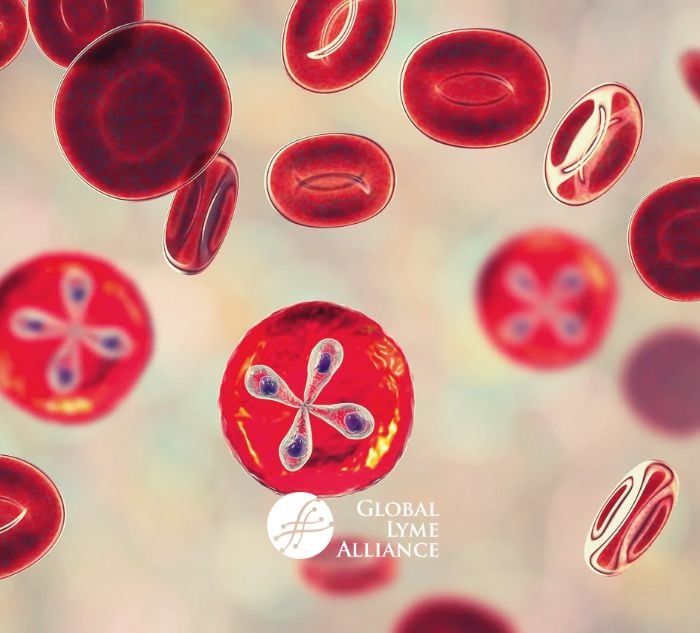
Learn about a breakthrough in the treatment of babesiosis using a combination of tafenoquine and atovaquone. This innovative approach shows potential for complete cure and immune protection, according to recent research.
The current treatments for babesiosis can come with severe side effects, the risk of drug resistance development, and may not completely eradicate all the parasites. In a recent publication, GLA-funded investigator Choukri Ben Mamoun, Ph.D. (Yale University) has brought attention to a significant advancement in babesiosis treatment. His research highlights the success of a dual therapy approach employing both antimalarials tafenoquine and atovaquone to treat babesiosis in mice. Intriguingly, mice were also protected from reinfection with Babesia if they were treated with tafenoquine alone or in combination with atovaquone during their first Babesia infection.
Babesiosis is a tick-borne illness caused by various Babesia parasites that infect red blood cells, and is a rising health concern, particularly for immunocompromised individuals. Patients experiencing symptoms of babesiosis typically present with flu-like manifestations, including fever, fatigue, chills, sweats, and headaches. The likelihood of severe babesiosis increases in immunocompromised individuals, giving rise to complications including acute respiratory distress syndrome, severe blood clotting, severe hemolytic anemia, splenic rupture, organ failure, and death. These symptoms and parasites exhibit remarkable similarity to malaria, necessitating laboratory testing for diagnosis.
The current treatments for babesiosis (quinine + clindamycin or atovaquone + azithromycin, a combination of antimalarials and antibiotics) are effective for many patients but require long and high dose treatments that can lead to severe side effects such as tinnitus, vertigo, and loss of hearing. Recent studies have also shown that these drug combinations may not kill all the parasites which leads to recurrence of the disease. Moreover, atovaquone-resistant parasites have been reported, further emphasizing the pressing need for innovative babesiosis therapies.
In 2018, the FDA approved tafenoquine for use as an antimalarial and in 2023, Edouard Vannier, PhD (Tufts University), a previous GLA funded investigator, and his colleagues documented the first successful treatment of an elderly, immunocompromised babesiosis patient with off label use of tafenoquine. Since then, physicians have used tafenoquine to treat two other immunocompromised patients and while one patient was cured, the other was not. These case reports suggest that it's worth studying how tafenoquine works together with other drugs to make them more effective against parasites while minimizing their side effects. Therefore Dr. Ben Mamoun’s lab studied the effectiveness of tafenoquine as a monotherapy and in combination with atovaquone for babesiosis in mice.
The first step involved evaluating the ability of tafenoquine to kill three diverse Babesia species cultivated in test tubes. These initial tests demonstrated that tafenoquine can kill all three species, implicating that it has broad antibabesial activity. Next, they found that tafenoquine monotherapy resulted in the elimination of all parasites in Babesia-infected mice, prolonging their survival. When used in combination with atovaquone, they achieved radical cure in both immunocompromised and immunocompetent mice infected with Babesia microti or Babesia duncani respectively. Radical cure is a term used in the area of malaria treatment, which means complete elimination of malaria parasites from the host. This is particularly noteworthy because the most severe babesiosis infections are often in patients receiving immunosuppressive treatment, such as rituximab, making them a high risk for relapsing babesiosis. By wiping out all parasites during the first treatment round, they cannot experience a relapse.
Beyond clearing infections, the study indicates that tafenoquine alone or in combination with atovaquone confers sterile immunity, which means the parasites are completely eliminated from the body before they can replicate inside red blood cells. Thus, immunocompetent individuals with babesiosis receiving tafenoquine treatment may experience protection against subsequent babesiosis infections. This encouraging finding will contribute valuable insights to the potential development of an effective babesiosis vaccine.
An important challenge to note about tafenoquine is that patients with a glucose-6-phosphate dehydrogenase (G6PD) deficiency cannot be prescribed tafenoquine. Individuals affected by this genetic disorder lack sufficient production of the G6PD enzyme, leading to the premature breakdown of their red blood cells. Tafenoquine exacerbates this effect, causing further red blood cell breakdown. If prescribed to someone with G6PD deficiency, it will result in an increased loss of red blood cells, necessitating hospitalization. Despite this challenge, the combination of tafenoquine and atovaquone presents a promising avenue for clinical translation. Further research and clinical trials will be crucial in solidifying these findings and bringing this innovative treatment approach to patients.
***








-2.jpg)